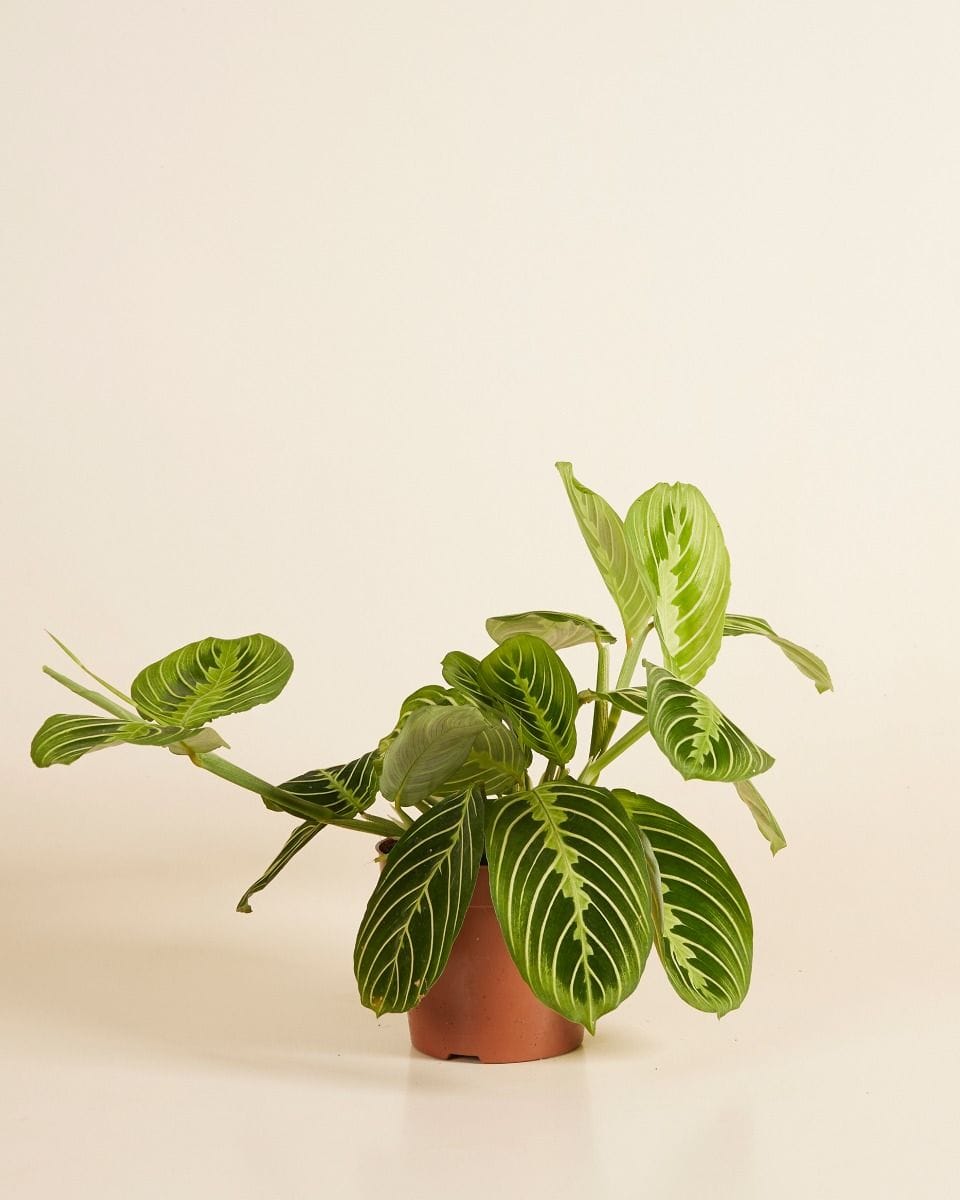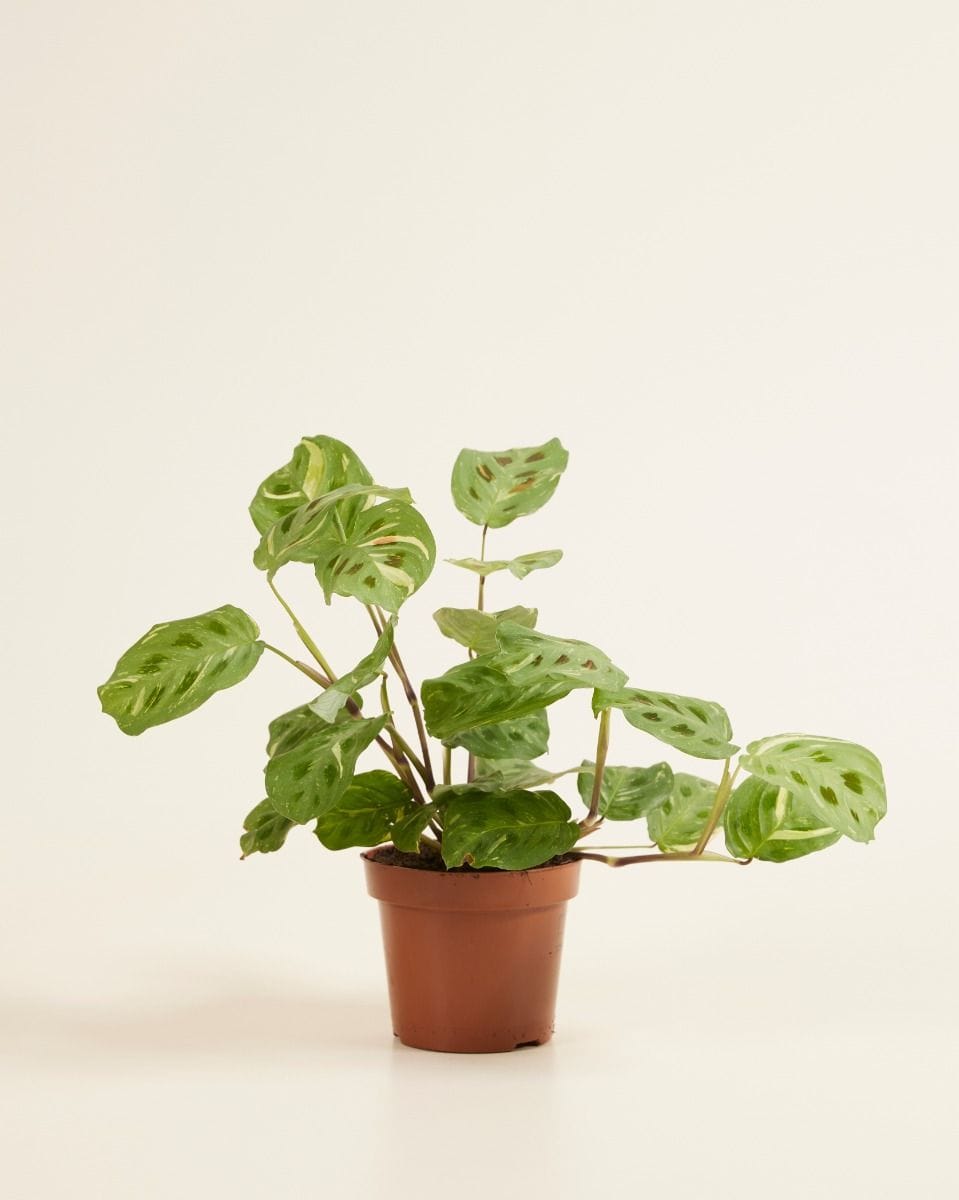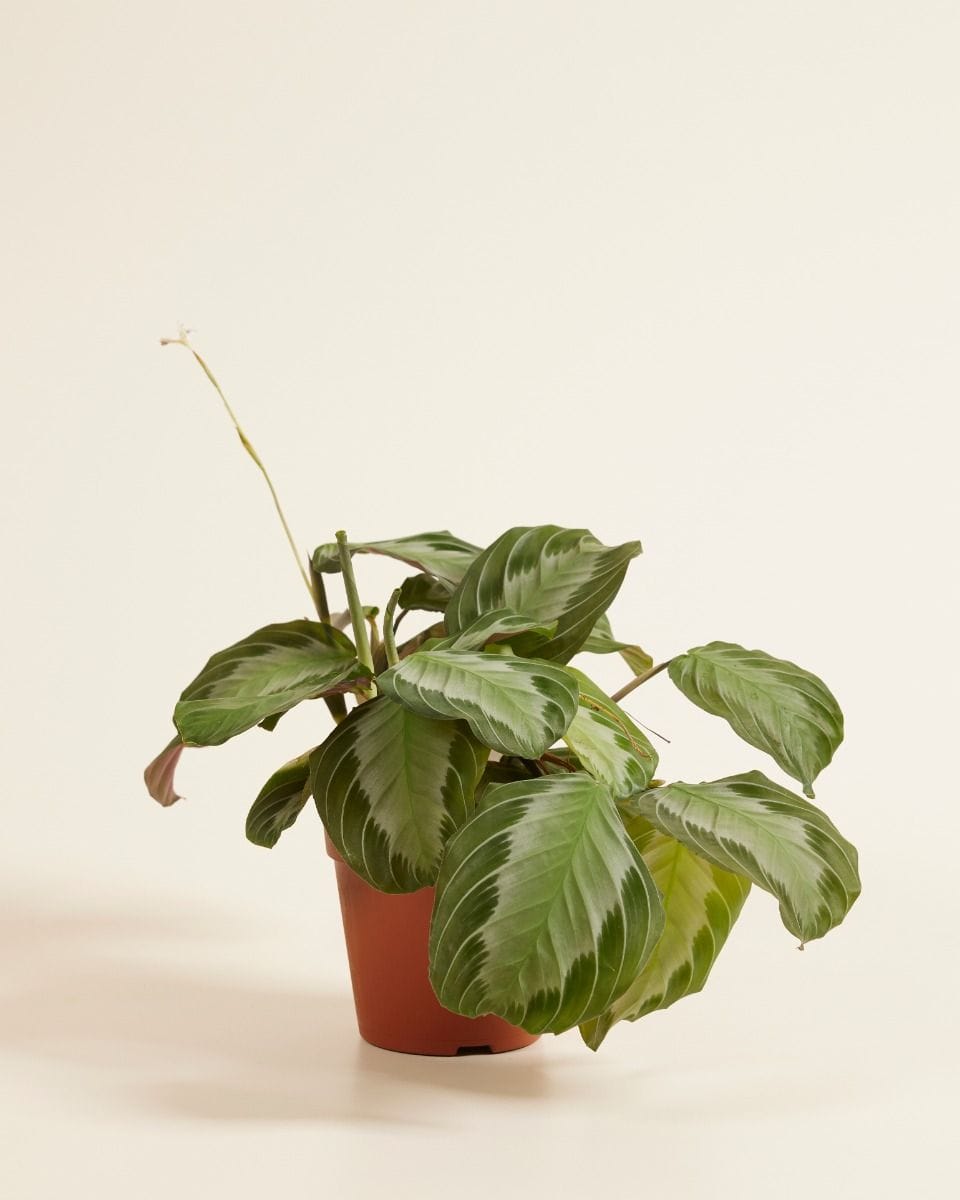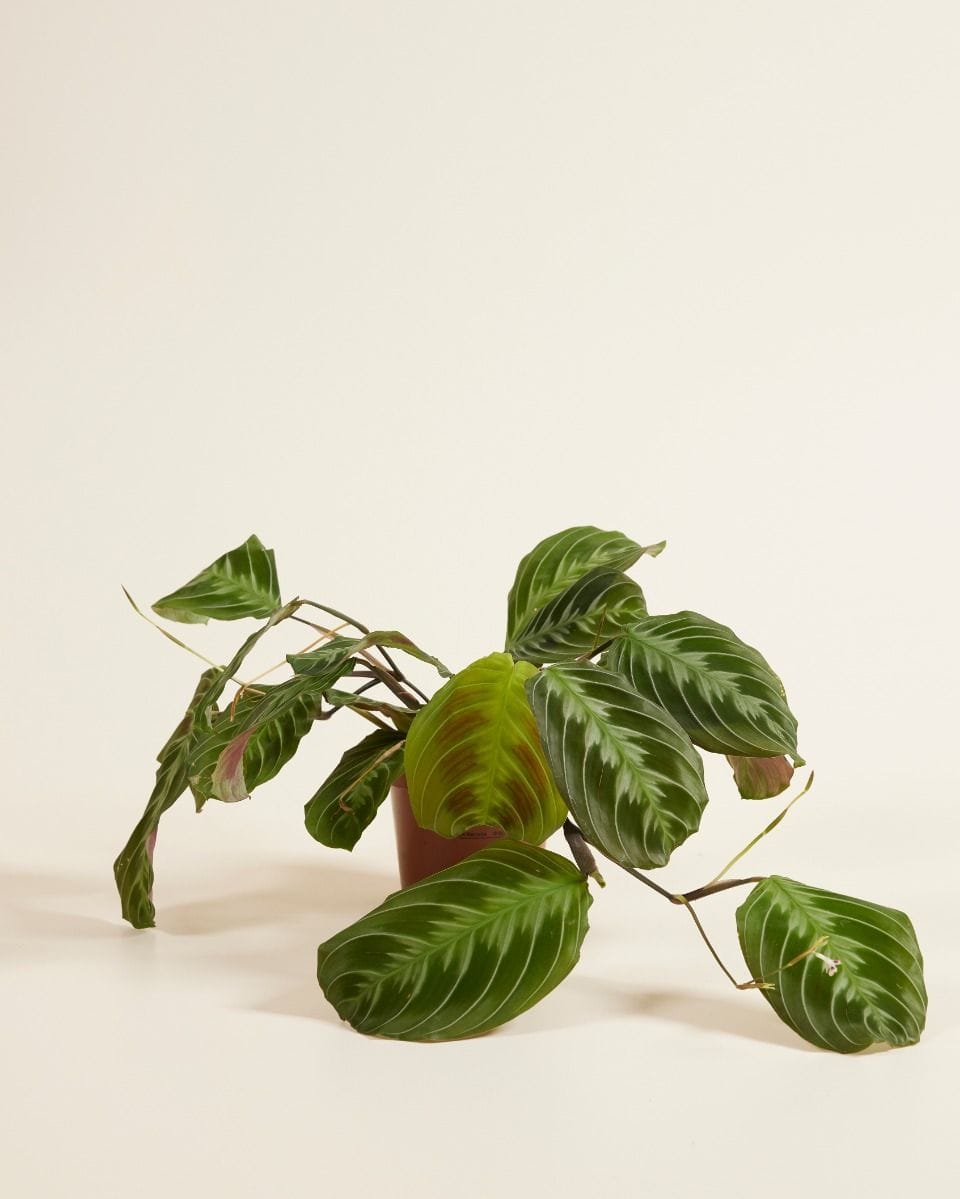Home delivery for £9.95 (no import fees)
In this article
- 1 How to care for Maranta (Prayer Plant) - Expert tips for Thriving Plants
- 1.1 Prayer Plant Care Tips
- 1.1.1 Light and placement for Maranta
- 1.1.2 Watering
- 1.1.3 Fertilisation
- 1.1.4 Temperature & Humidity
- 1.1.5 Soil & Repotting
- 1.1.6 Propagating Maranta
- 1.1.7 Most common pest on Maranta
- 1.1.8 Maranta Leuconeura Varieties
- 1.1.9 Is the Maranta toxic for pets or children?
- 1.1.10 Buy your new Maranta at PLNTS.com
How to care for Maranta (Prayer Plant) - Expert tips for Thriving Plants
Maranta Leuconeura, also called Prayer Plant, is a lovely and trendy indoor plant admired for its stunning foliage and low maintenance. The leaves are a gorgeous blend of greens, reds, and purples, creating detailed patterns. Although it produces small, unremarkable flowers, it is mostly grown for its beautiful leaves.
Maranta is a genus of flowering plants in the Marantaceae family. It's found in Central and South American tropical regions and the West Indies. There are around 40 different species of Maranta known today.
The common name Prayer Plant or Praying Plant refers to members of the Maranta genus, which includes several species of plants with strikingly patterned leaves that fold up at night, as if in prayer. The closely related Calathea genus also includes plants that are sometimes called Prayer Plants because they show similar leaf movements.

Maranta (Prayer Plant) care: 10 expert tips for growing it successfully
- Find a spot with filtered bright light. Marantas love lots of indirect light, so place them near a window with filtered light or a few feet away from a bright window.
- Make sure to keep the soil of your Maranta plant consistently moist. Water it regularly to ensure that the soil doesn't dry out completely.
- Prayer Plants thrive in high humidity. You can boost humidity by placing a humidifier close to your plant or regularly misting the leaves to keep the air moist.
- When misting your Prayer Plant, it's essential not to get the leaves too wet. Overly wet leaves can lead to fungal growth and other issues. Make sure to mist from a distance and avoid spraying water directly onto the leaves.
- Avoid cold drafts and temperature fluctuations. Marantas are sensitive to cold drafts, so keep them away from drafty windows or doors.
- Don't worry if you see your Maranta moving its leaves. It's a natural behaviour! Marantas are known for their unique leaf movements, opening and closing their leaves in response to changes in light and darkness.
- Remember to fertilise regularly. Marantas benefit from regular fertilisation during their growing season. Use a water-soluble fertiliser every 2-4 weeks.
- Pruning your Maranta plant regularly will help it grow bushier. This will encourage the growth of new stems and leaves, resulting in a fuller and more bushy appearance.
- If you spot brown tips on the leaves of your Maranta, it could be an indication of low air humidity or overwatering. Changing your care routine can help resolve the problem.
- Some Maranta varieties have a trailing growth habit and will eventually start to hang down as they grow larger. Give them enough space or place them in a hanging basket to showcase their unique foliage.
Prayer Plant Care Tips
Light and placement for Maranta
Hang or place the Maranta near a window that receives bright indirect sunlight. Never place the plant in direct sunlight because the sun will scorch the leaves of the plant. The leaves will also develop brown or yellow spots and decrease colour intensity.
Expert tip! It is important to keep your Maranta plant in bright light during the winter to ensure its growth. You can move the plant closer to a window if necessary to ensure it gets enough light.
Maranta plants can tolerate medium shade but don't do well in dark corners. When Maranta plants don't receive enough light, their leaves may become dull and lose their variegation. They may also become leggy as they stretch towards the light source.

Watering
Finding the perfect watering routine for your Marantas may take some time, so don't worry if it doesn't come naturally at first. Remember, they thrive in consistently moist soil. Neither will they tolerate completely dry soil nor too wet soil. It's usually best to water it when its top layer has dried out slightly.
During the winter months, you may need to water your Maranta a little less frequently because the soil takes longer to dry out, but keeping the soil consistently moist is still essential. To determine soil moisture more easily, you can use a water meter.
Expert tip! It's important to avoid getting water on the leaves when watering. Leaving water on the leaves of a Maranta plant can create a moist environment conducive to mold growth. If your Maranta is under or overwatered, it may start to curl its leaves and develop yellow or brown leaves. When you water your Maranta, it's best to use room-temperature or slightly warm water.
Fertilisation
During the growing season (early spring to autumn), it's good to fertilise your Maranta every 2-4 weeks with PLNTS Nutrition Plant Food. However, it's important to avoid fertilising during the winter months when the plant is dormant.
Temperature & Humidity
Marantas are tropical plants that thrive in warm and humid conditions. To ensure your Maranta grows best, keep the room temperature within 18-24°C and the humidity level around 40-60%. Your Maranta will love that! However, if the air humidity is too low, the plant will curl its leaves to reduce water loss. Here are our best tips for raising the humidity.
During the summer, you can take your Maranta outside to a terrace or closed balcony, as long as it's protected from the wind, direct sunlight, and extreme temperature changes. It can tolerate a minimum temperature of 15°C.

Soil & Repotting
Maranta Leuconeura usually needs repotting after 1-3 years. Choose a slightly larger pot and use well-draining PLNTS organic houseplant soil. Read our best tips on how to repot houseplants.
Propagating Maranta
Propagating a Maranta is a surprisingly easy way to expand your collection and use larger mother plants. The most common (and easiest) way to propagate praying plants is to divide the plant during repotting.
Just follow these easy steps:
- If you are repotting your Prayer Plant, divide it into several smaller plants by gently shaking the soil away from the roots.
- Make sure that each new plant has a good mass of roots and several stems.
- Plant these new smaller plants separately in smaller pots.
- Keep the new divisions very warm and moist for the first few weeks until new growth appears.
Propagating Prayer Plants can be done any time of the year, but it's ideal to do it in the spring or summer when the plant is in its active growth phase.

Most common pest on Maranta
Like many houseplants, Maranta plants are susceptible to spider mites and mealybugs. If you see a white powdery substance on the leaves or brown discolouration, you can use a natural insecticide like neem oil solution to get rid of them.
Keep a close eye on your Maranta, and if in doubt, visit our PLNTS doctor page. This will help you determine which pests are bothering your plant and how to best combat them.
Maranta Leuconeura Varieties
Marantas come in a range of beautiful colours, shapes, and sizes. Maranta Lemon Lime features bright green leaves with vibrant yellow veins, adding a bold touch of colour to your space. The Silver Band has striking silver stripes running along the edges of its leaves, while the Cat Moustache (NoID) Maranta has a playful leaf shape that resembles a cat's whiskers. Maranta Kerchoveana Variegated is known for its stunning green and yellow variegation that creates a striking contrast against any backdrop.
Is the Maranta toxic for pets or children?
Good news! This beautiful plant is also completely safe for your pets or children as this Maranta is not poisonous. However, it's still important to make sure that your furry friends don't eat the entire plant. We definitely want to avoid any stomach issues.
Buy your new Maranta at PLNTS.com
At PLNTS.com you can buy your new Maranta online. Whether you like your PLNTS big from the start or prefer to grow them from tiny BabyPLNTS into full-grown PLNTS - buy Maranta plants online at PLNTS.com.




